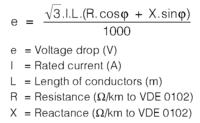Hello everyone,
I was looking carefully at all the topics related to the selection of cabling for the installation. However, I cannot translate this into the case that I have to calculate.
- lighting installation emergency, fireproof cables
- the necessary formula to calculate the min. cable cross-section S
- I have the following data: power of all receivers in the circuit P = 437W, Un = 230V, In = 1.88A, circuit length L = 130m, copper -> conductivity 58 S * m / mm2, max. permissible voltage drop in the circuit dU = 3%
I will have a few such calculations to do, it is mainly about the formula and a short comment on why the cable cross-section is selected in such a way. The case is divided into sections of 1.5-2.5 mm2. However, I have to justify it and present the relevant calculations.
One of the forum members advised me to calculate it from the formula below, but I don't know where I'm making a mistake
R = [ro] xl / S
[ro] - by this I mean the resistivity for copper 1.7 ? 10-8
after conversion:
S = ([ro] xl) / R
R = U / I -> R = 230 / 1.88 = 122.34
so: S = (1.7 ? 10-8 x 130) / 122.34 = 1.80 x 10-8 mm2 ????? that is nonsense; /
Colleagues, I am asking for help and possibly some materials.
I was looking carefully at all the topics related to the selection of cabling for the installation. However, I cannot translate this into the case that I have to calculate.
- lighting installation emergency, fireproof cables
- the necessary formula to calculate the min. cable cross-section S
- I have the following data: power of all receivers in the circuit P = 437W, Un = 230V, In = 1.88A, circuit length L = 130m, copper -> conductivity 58 S * m / mm2, max. permissible voltage drop in the circuit dU = 3%
I will have a few such calculations to do, it is mainly about the formula and a short comment on why the cable cross-section is selected in such a way. The case is divided into sections of 1.5-2.5 mm2. However, I have to justify it and present the relevant calculations.
One of the forum members advised me to calculate it from the formula below, but I don't know where I'm making a mistake
R = [ro] xl / S
[ro] - by this I mean the resistivity for copper 1.7 ? 10-8
after conversion:
S = ([ro] xl) / R
R = U / I -> R = 230 / 1.88 = 122.34
so: S = (1.7 ? 10-8 x 130) / 122.34 = 1.80 x 10-8 mm2 ????? that is nonsense; /
Colleagues, I am asking for help and possibly some materials.




